Ultrastructural Evidence Elucidates the Mode of Action of Sulfur in Preventing Pollen Tube Development in Stigma of Citrus cv. Nadorcott and Other Horticultural Species
Abstract
1. Introduction
2. Materials and Methods
2.1. Plant Material
2.2. Treatments
2.3. Analyzed Tissues
2.4. Flower Sampling
2.5. Observation by Epifluorescence Microscopy, (EFM)
2.6. Observation by Light Microscopy (LM)
2.7. Observation by Transmission Electron Microscopy, (TEM)
2.8. Observation by Scanning Electron Microscopy, (SEM)
3. Results
3.1. Pollen Tube Development Inside the Nadorcott Stigma
3.2. General View of the Untreated and Treated Nadorcott Stigmas
3.3. Region of Elongated Cells (Upper Papillae)
3.4. Basal Papillary Cell Region
3.5. Stigmatoid Tissue
3.6. Stylar Canals
3.7. Effect on Exudate
3.8. Outcome for Other Citrus Species
3.9. Preliminary Outcomes of Other Horticultural Species
4. Discussion
5. Conclusions
6. Patents
Supplementary Materials
Author Contributions
Funding
Data Availability Statement
Acknowledgments
Conflicts of Interest
References
- Heslop-Harrison, J. Male Gametophyte Selection and the Pollen-Stigma Interaction. In Gamete Competition in Plants and Animals; Mulcahy, D.L., Ed.; North Holland: Amsterdam, The Netherlands, 1975; pp. 177–190. [Google Scholar]
- Heslop-Harrison, J.; Heslop-Harrison, Y.; Barber, J. The Stigma Surface in Incompatibility Responses. Proc. R. Soc. London Ser. B. Biol. Sci. 1975, 188, 287–297. [Google Scholar] [CrossRef]
- Gaude, T.; McCormick, S. Signaling in Pollen-Pistil Interactions. Semin. Cell Dev. Biol. 1999, 10, 139–147. [Google Scholar] [CrossRef] [PubMed]
- Acosta, M.G.; Lassaga, S.L.; Casco, V.H. Estudio y Caracterización de La Naturaleza Química de La Adhesión Celular Polen-Estigma En Arabidopsis thaliana. Rev. Científica Agropecu. 2007, 11, 141–147. [Google Scholar]
- Linskens, H.F. Recognition during the Progamic Phase. In Biology of Reproduction and Cell Motility in Plants and Animals; Cresti, M., Dallai, R., Eds.; University of Siena: Siena, Italy, 1986; pp. 21–32. [Google Scholar]
- Cheung, A.Y. Pollen-Pistil Interactions during Pollen-Tube Growth. Trends Plant Sci. 1996, 1, 45–51. [Google Scholar] [CrossRef]
- Gotelli, M.M.; Lattar, E.C.; Zini, L.M.; Galati, B.G. Style Morphology and Pollen Tube Pathway. Plant Reprod. 2017, 30, 155–170. [Google Scholar] [CrossRef] [PubMed]
- Bell, P.R. Incompatibility in Flowering Plants: Adaptation of an Ancient Response. Plant Cell 1995, 7, 5–16. [Google Scholar] [CrossRef]
- Herrero, M.; Hormaza, J.I. Pistil Strategies Controlling Pollen Tube Growth. Sex. Plant Reprod. 1996, 9, 343–347. [Google Scholar] [CrossRef]
- Sage, T.L.; Hristova-Sarkovski, K.; Koehl, V.; Lyew, J.; Pontieri, V.; Bernhardt, P.; Weston, P.; Bagha, S.; Chiu, G. Transmitting Tissue Architecture in Basal-Relictual Angiosperms: Implications for Transmitting Tissue Origins. Am. J. Bot. 2009, 96, 183–206. [Google Scholar] [CrossRef]
- Williams, J.H.; Mcneilage, R.T.; Lettre, M.T.; Taylor, M.L. Pollen Tube Growth and the Pollen-Tube Pathway of Nymphaea odorata (Nymphaeaceae). Bot. J. Linn. Soc. 2010, 162, 581–593. [Google Scholar] [CrossRef]
- Endress, P.K.; Igersheim, A. Gynoecium Structure and Evolution in Basal Angiosperms. Int. J. Plant Sci. 2000, 161, S211–S213. [Google Scholar] [CrossRef]
- Williams, J.H. Amborella trichopoda (Amborellaceae) and the Evolutionary Developmental Origins of the Angiosperm Progamic Phase. Am. J. Bot. 2009, 96, 144–165. [Google Scholar] [CrossRef] [PubMed]
- Endress, P.K. Angiosperm Ovules: Diversity, Development, Evolution. Ann. Bot. 2011, 107, 1465–1489. [Google Scholar] [CrossRef] [PubMed]
- Endress, P.K. Patterns of Angiospermy Development before Carpel Sealing across Living Angiosperms: Diversity, and Morphological and Systematic Aspects. Bot. J. Linn. Soc. 2015, 178, 556–591. [Google Scholar] [CrossRef]
- Endress, P.K. Syncarpy and Alternative Modes of Escaping Disadvantages of Apocarpy in Primitive Angiosperms. Taxon 1982, 31, 48–52. [Google Scholar] [CrossRef]
- Ferreira, J.A.B.; Ledo, C.A.S.; Souza, F.V.D.; Conceição, J.Q.; Rossi, M.L.; Souza, E.H. Stigma Structure and Receptivity in Papaya (Carica papaya L.). Acad. Bras. Cienc. 2021, 93, 20190605. [Google Scholar] [CrossRef] [PubMed]
- Souza, E.H.; Carmello-Guerreiro, S.M.; Souza, F.V.D.; Rossi, M.L.; Martinelli, A.P. Stigma Structure and Receptivity in Bromeliaceae. Sci. Hortic. 2016, 203, 118–125. [Google Scholar] [CrossRef]
- Teixeira, S.P.; Costa, M.F.B.; Basso-Alves, J.P.; Kjellberg, F.; Pereira, R.A.S. Morphological Diversity and Function of the Stigma in Ficus Species (Moraceae). Acta Oecologica. 2018, 90, 117–131. [Google Scholar] [CrossRef]
- Heslop-Harrison, J.; Heslop-Harrison, Y. The Pollen-Stigma Interaction in the Grasses. I. Fine-Structure and Cytochemistry of the Stigmas of Hordeum and Secale. Acta Bot. Neerl. 1980, 29, 261–276. [Google Scholar] [CrossRef]
- Linskens, H.F.; Heinen, W. Cutinase-Nachweis in Pollen. Z. Bot. 1962, 50, 338–347. [Google Scholar]
- Mattsson, O.; Knox, R.B.; Heslop-Harrison, J.; Heslop-Harrison, Y. Protein Pellicle of Stigmatic Papillae as a Probable Recognition Site in Incompatibility Reactions. Nature 1974, 247, 298–300. [Google Scholar] [CrossRef]
- Safavian, D.; Goring, D.R. Secretory Activity is Rapidly Induced in Stigmatic Papillae by Compatible Pollen, but Inhibited for Self-Incompatible Pollen in the Brassicaceae. PLoS ONE 2013, 8, e84286. [Google Scholar] [CrossRef] [PubMed]
- Heslop-Harrison, Y.; Shivanna, K.R. The Receptive Surface of the Angiosperm Stigma. Ann. Bot. 1977, 41, 1233–1258. [Google Scholar] [CrossRef]
- Katano, K.; Suzuki, N. What Are the Key Mechanisms That Alter the Morphology of Stigmatic Papillae in Arabidopsis thaliana? Plant Signal. Behav. 2021, 16, 1980999. [Google Scholar] [CrossRef] [PubMed]
- Lu, X.; Ye, X.; Hu, Z.; Liu, J. The Morphology of Stigma of Asteraceae Observed by Scanning Electron Microscopy. Microsc. Res. Tech. 2022, 85, 2292–2304. [Google Scholar] [CrossRef] [PubMed]
- Jordaan, A.; Wessels, D.C.J.; Krüger, H. Structure of the Style and Wet Non-Papillate Stigma of Colophospermum mopane, Caesalpinioideae: Detarieae. Bot. J. Linn. Soc. 2002, 139, 295–304. [Google Scholar] [CrossRef]
- Owens, S.J. The Morphology of the Wet, Non-Papillate (WN) Stigma Form in the Tribe Caesalpinieae (Caesalpinioideae: Leguminosae). Bot. J. Linn. Soc. 1990, 104, 293–302. [Google Scholar] [CrossRef]
- Slater, A.T.; Calder, D.M. Fine Structure of the Wet, Detached Cell Stigma of the Orchid Dendrobium speciosum Sm. Sex. Plant Reprod. 1990, 3, 61–69. [Google Scholar] [CrossRef]
- Shivanna, K.R.; Sastri, D.C. Stigma-Surface Esterase Activity and Stigma Receptivity in Some Taxa Characterized by Wet Stigmas. Ann. Bot. 1981, 47, 53–64. [Google Scholar] [CrossRef]
- de Nettancourt, D. Incompatibility in Angiosperms; Springer: Berlin/Heidelberg, Germany, 1977. [Google Scholar] [CrossRef]
- Ciampolini, F.; Cresti, M.; Sarfatti, G.; Tiezzi, A. Ultrastructure of the Stylar Canal Cells of Citrus limon (Rutaceae). Plant Syst. Evol. 1981, 138, 263–274. [Google Scholar] [CrossRef]
- Cresti, M.; Ciampolini, F.; van Went, J.L.; Wilms, H.J. Ultrastructure and Histochemistry of Citrus limon (L.) Stigma. Planta 1982, 156, 1–9. [Google Scholar] [CrossRef]
- Distefano, G.; Gentile, A.; Herrero, M. Pollen-Pistil Interactions and Early Fruiting in Parthenocarpic Citrus. Ann. Bot. 2011, 108, 499–509. [Google Scholar] [CrossRef]
- Edlund, A.F.; Swanson, R.; Preuss, D. Pollen and Stigma Structure and Function: The Role of Diversity in Pollination. Plant Cell 2004, 16, S84–S97. [Google Scholar] [CrossRef]
- Graaf, B.H.J.D.; Derksen, J.W.M.; Mariani, C. Pollen and Pistil in the Progamic Phase. Sex. Plant Reprod. 2001, 14, 41–55. [Google Scholar] [CrossRef]
- Swanson, R.; Edlund, A.F.; Preuss, D. Species Specificity in Pollen-Pistil Interactions. Annu. Rev. Genet. 2004, 38, 793–818. [Google Scholar] [CrossRef]
- Ciampolini, F.; Cresti, M.; Kapil, R.N.; Crest, M. Fine Structural and Cytochemical Characteristics of Style and Stigma in Olive. Caryologia 1983, 36, 211–230. [Google Scholar] [CrossRef]
- Bigazzi, M.; Selvi, F. Stigma Form and Surface in the Tribe Boragineae (Boraginaceae): Micromorphological Diversity, Relationships with Pollen, and Systematic Relevance. Can. J. Bot. 2000, 78, 388–408. [Google Scholar]
- Herrero, M.; Dickinson, H.G. Pollen-Pistil Incompatibility in Petunia hybrida: Changes in the Pistil Following Compatible and Incompatible Intraspecific Crosses. J. Cell Sci. 1979, 36, 1–18. [Google Scholar] [CrossRef]
- Labarca, C.; Loewus, F. The Nutritional Role of Pistil Exudate in Pollen Tube Wall Formation in Lilium longiflorum: II. Production and Utilization of Exudate from Stigma and Stylar Canal. Plant Physiol. 1973, 52, 87–92. [Google Scholar] [CrossRef] [PubMed]
- Herrero, M.; Dickinson, H.G. Pollen Tube Development in Petunia hybrida Following Compatible and Incompatible Intraspecific Matings. J. Cell Sci. 1981, 47, 365–383. [Google Scholar] [CrossRef]
- Stephenson, A.G.; Travers, S.E.; Mena-Ali, J.I.; Winsor, J.A. Pollen Performance before and during the Autotrophic-Heterotrophic Transition of Pollen Tube Growth. Philos. Trans. R. Soc. London. Ser. B Biol. Sci. 2003, 358, 1009–1018. [Google Scholar] [CrossRef] [PubMed]
- Sassen, M.M.A. The Stylar Transmitting Tissue. Acta Bot. Neerl. 1974, 23, 99–108. [Google Scholar] [CrossRef]
- Lennon, K.A.; Roy, S.; Hepler, P.K.; Lord, E.M. The Structure of the Transmitting Tissue of Arabidopsis thaliana (L.) and the Path of Pollen Tube Growth. Sex. Plant Reprod. 1998, 11, 49–59. [Google Scholar] [CrossRef]
- Knox, R.B. Pollen—Pistil interaction. In Encyclopedia Plant Physiology; Linskens, H.F., Heslop-Harrison, J., Eds.; Cellular Interactions; Springer: Berlin/Heidelberg, Germany; New York, NY, USA; Tokyo, Japan, 1984; pp. 508–608. [Google Scholar]
- Heslop-Harrison, J. Pollen Germination and Pollen-Tube Growth. Int. Rev. Cytol. 1987, 107, 1–78. [Google Scholar] [CrossRef]
- Wu, H.M.; Wang, H.; Cheung, A.Y. A Pollen Tube Growth Stimulatory Glycoprotein Is Deglycosylated by Pollen Tubes and Displays a Glycosylation Gradient in the Flower. Cell 1995, 82, 395–403. [Google Scholar] [CrossRef]
- Jauh, G.Y.; Lord, E.M. Movement of the Tube Cell in the Lily Style in the Absence of the Pollen Grain and the Spent Pollen Tube. Sex. Plant Reprod. 1995, 8, 168–172. [Google Scholar] [CrossRef]
- Wilhelmi, L.K.; Preuss, D. Self-Sterility in Arabidopsis Due to Defective Pollen Tube Guidance. Science 1996, 274, 1535–1537. [Google Scholar] [CrossRef]
- Wilhelmi, L.K.; Preuss, D. The Mating Game: Pollination and Fertilization in Flowering Plants. Curr. Opin. Plant Biol. 1999, 2, 18–22. [Google Scholar] [CrossRef] [PubMed]
- Shimizu, K.K.; Okada, K. Attractive and Repulsive Interactions between Female and Male Gametophytes in Arabidopsis Pollen Tube Guidance. Development 2000, 127, 4511–4518. [Google Scholar] [CrossRef] [PubMed]
- Hudäk, J.; Walles, B.; Vennigerholz, F. The Transmitting Tissue in Brugmansia suaveolens L.: Ultrastructure of the Stylar Transmitting Tissue. Ann. Bot. 1993, 71, 177–186. [Google Scholar] [CrossRef]
- Wilhelmi, L.K.; Preuss, D. Blazing New Trails (Pollen Tube Guidance in Flowering Plants). Plant Physiol. 1997, 113, 307–312. [Google Scholar] [CrossRef] [PubMed]
- Jauh, G.Y.; Eckard, K.J.; Nothnagel, E.A.; Lord, E.M. Adhesion of Lily Pollen Tubes on an Artificial Matrix. Sex. Plant Reprod. 1997, 10, 173–180. [Google Scholar] [CrossRef]
- Vennigerholz, F. The Transmitting Tissue in Brugmansia suaveolens: Immunocytochemical Localization of Pectin in the Style. Protoplasma 1992, 171, 117–122. [Google Scholar] [CrossRef]
- Malhó, R. Pollen Tube Guidance—The Long and Winding Road. Sex. Plant Reprod. 1998, 11, 242–244. [Google Scholar] [CrossRef]
- Lind, J.L.; Bönig, I.; Clarke, A.E.; Anderson, M.A. A Style-Specific 120-KDa Glycoprotein Enters Pollen Tubes of Nicotiana alata in Vivo. Sex. Plant Reprod. 1996, 9, 75–86. [Google Scholar] [CrossRef]
- Kroh, M.; Miki-Hirosige, H.; Rosen, W.; Loewus, F. Incorporation of Label into Pollen Tube Walls from Myoinositol-Labeled Lilium longiflorum Pistils. Plant Physiol. 1970, 45, 92–94. [Google Scholar] [CrossRef]
- Rosen, W.G.; Thomas, H.R. Secretory Cells of Lily pistils. I. Fine structure ans Function. Am. J. Bot. 1970, 57, 1108–1114. [Google Scholar] [CrossRef]
- Vasilev, A.E. Ultrastructure of Stigmatoid Cells in Lilium. Sov Plant Physiol 1970, 17, 1035–1044. [Google Scholar]
- Clarke, A.E.; Considine, J.A.; Ward, R.; Knox, R.B. Mechanism of Pollination in Gladiolus: Roles of Stigma and Pollen Tube Guide. Ann. Bot. 1977, 41, 15–20. [Google Scholar] [CrossRef]
- Tilton, V.R.; Horner, H.T. Stigma, Style, and Obturator of Ornithogalum caudatum (Liliaceae) and Their Function in the Reproductive Process. Am. J. Bot. 1980, 67, 1113–1131. [Google Scholar] [CrossRef]
- Owens, S.J.; Mcgrath, S.; Fraser, M.A.; Fox, L.R. The Anatomy, Histochemistry and Ultrastructure of Stigmas and Styles in Commelinaceae. Ann. Bot. 1984, 54, 591–603. [Google Scholar] [CrossRef]
- Lord, E.M.; Kohorn, L.U. Gynoecial Development, Pollination, and the Path of Pollen Tube Growth in the Tepary Bean, Phaseolus acutifolius. Am. J. Bot. 1986, 73, 70–78. [Google Scholar] [CrossRef]
- Leins, P.; Erbar, C. Floral Morphological Studies in the South African Cyphia stenopetala Diels (Cyphiaceae). Int. J. Plant Sci. 2005, 166, 207–217. [Google Scholar] [CrossRef]
- Reinhardt, S.; Ewalda, A.; Hellwig, F. The Anatomy of the Stigma and Style from Cyclamen persicum (Mill.) Cv. “Pure White” and Its Relation to Pollination Success. Plant Biol. 2007, 9, 158–162. [Google Scholar] [CrossRef] [PubMed]
- Castro, S.; Silva, S.; Stanescu, I.; Silveira, P.; Navarro, L.; Santos, C. Pistil Anatomy and Pollen Tube Development in Polygala Vayredae Costa (Polygalaceae). Plant Biol. 2009, 11, 405–416. [Google Scholar] [CrossRef]
- Galati, B.G.; Rosenfeldt, S.; Zarlavsky, G.; Gotelli, M.M. Ultrastructure of the Stigma and Style of Cabomba caroliniana Gray (Cabombaceae). Protoplasma 2016, 253, 155–162. [Google Scholar] [CrossRef]
- Gotelli, M.M.; Galati, B.G.; Medan, D. Structure of the Stigma and Style in Colletia and Discaria (Rhamnaceae: Colletieae). Plant Syst. Evol. 2012, 298, 1635–1641. [Google Scholar] [CrossRef]
- Garmendia, A.; Beltrán, R.; Zornoza, C.; Breijo, F.; Reig, J.; Bayona, I.; Merle, H. Insect Repellent and Chemical Agronomic Treatments to Reduce Seed Number in ‘Afourer’ Mandarin. Effect on Yield and Fruit Diameter. Sci. Hortic. 2019, 246, 437–447. [Google Scholar] [CrossRef]
- Garmendia, A.; García-Breijo, F.; Reig, J.; Raigón, M.D.; Beltrán, R.; Zornoza, C.; Cebrián, N.; Merle, H. Agronomic Treatments to Avoid Seed Presence in ‘Nadorcott’ Mandarin I. Effect on in Vivo Pollen Tube Growth. Sci. Hortic. 2022, 294, 110760. [Google Scholar] [CrossRef]
- Garmendia, A.; Raigón, M.D.; García-Breijo, F.; Reig, J.; Beltrán, R.; Zornoza, C.; Cebrián, N.; Merle, H. Agronomic Treatments to Avoid Presence of Seeds in Nadorcott Mandarin II. Effect on Seed Number per Fruit and Yield. PLoS ONE 2022, 17, e0278934. [Google Scholar] [CrossRef] [PubMed]
- Nadori, E.B. Mandarin Tangerine Called Nadorcott. U.S. Patent 10,480, 7 July 1998. [Google Scholar]
- Morris, J.K. A Formaldehyde Glutaraldehyde Fixative of High Osmolality for Use in Electron Microscopy. J. Cell Biol. 1965, 27, 1A–149A. [Google Scholar]
- Molins, A.; Moya, P.; García-Breijo, F.J.; Reig-Armiñana, J.; Barreno, E. A Multi-Tool Approach to Assess Microalgal Diversity in Lichens: Isolation, Sanger Sequencing, HTS and Ultrastructural Correlations. Lichenologist 2018, 50, 123–138. [Google Scholar] [CrossRef]
- Ruzin, S.E. Plant Microtechnique and Microscopy; Oxford University Press: New York, NY, USA, 1999. [Google Scholar]
- Wetzstein, H.Y.; Law, S.E. Enhanced Visualization of the Fine Structure of the Stigmatic Surface of Citrus Using Pre-Fixation Washes. J. Am. Soc. Hortic. Sci. 2012, 137, 290–293. [Google Scholar] [CrossRef]
- Gambetta, G.; Gravina, A.; Fasiolo, C.; Fornero, C.; Galiger, S.; Inzaurralde, C.; Rey, F. Self-Incompatibility, Parthenocarpy and Reduction of Seed Presence in “Afourer” Mandarin. Sci. Hortic. 2013, 164, 183–188. [Google Scholar] [CrossRef]
- Gonzatto, M.P.; Griebeler, S.R.; de Almeida, G.K.; Munhoz, B.d.O.; Sulzbach, M.; Schwarz, S.F. Parthenocarpy Induction and Reduction of Seeds in Fruits of Nadorcott’mandarin. Rev. Ceres 2022, 69, 167–172. [Google Scholar] [CrossRef]
- Beltrán, R.; Cebrián, N.; Zornoza, C.; Breijo, F.G.; Armiñana, J.R.; Garmendia, A.; Merle, H. Effect of Sulfur on Pollen Germination of Clemenules Mandarin and Nova Tangelo. PeerJ 2023, 11, e14775. [Google Scholar] [CrossRef]
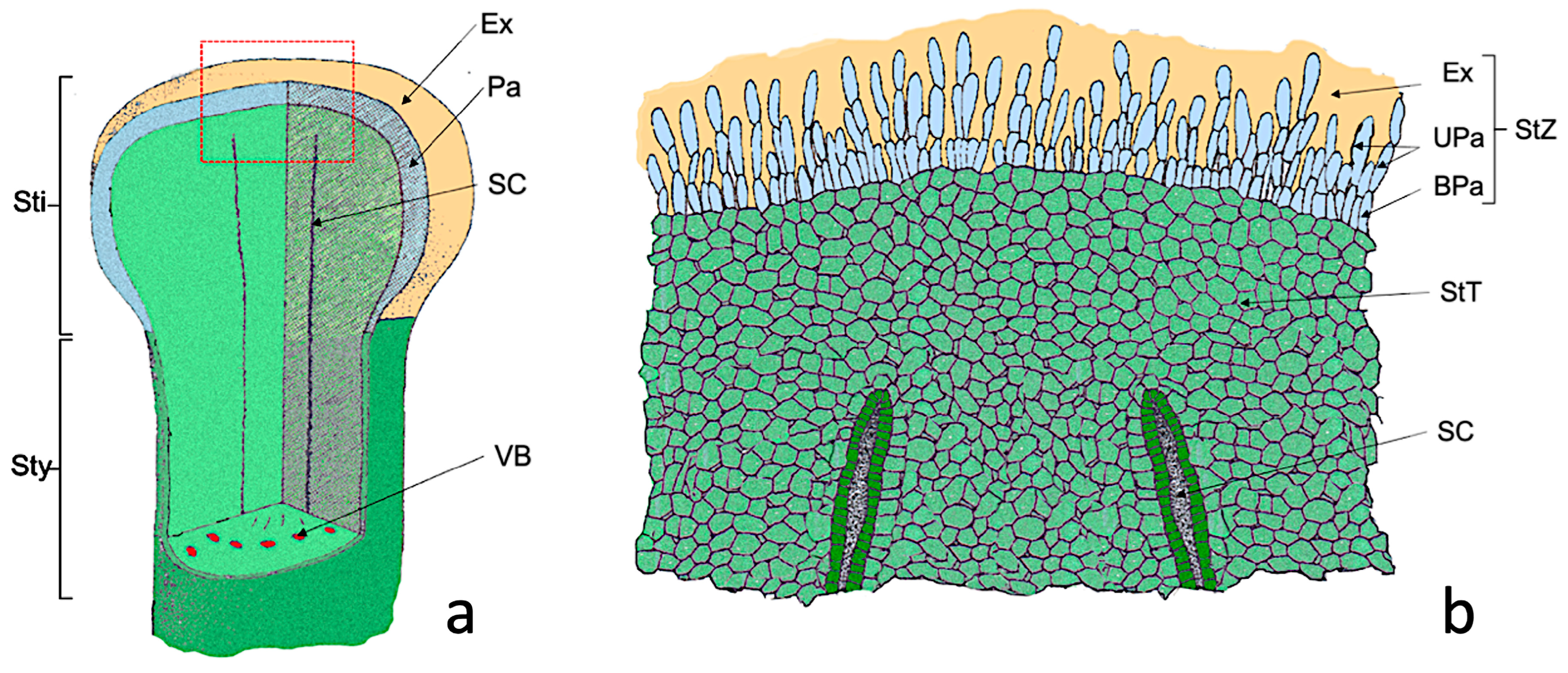

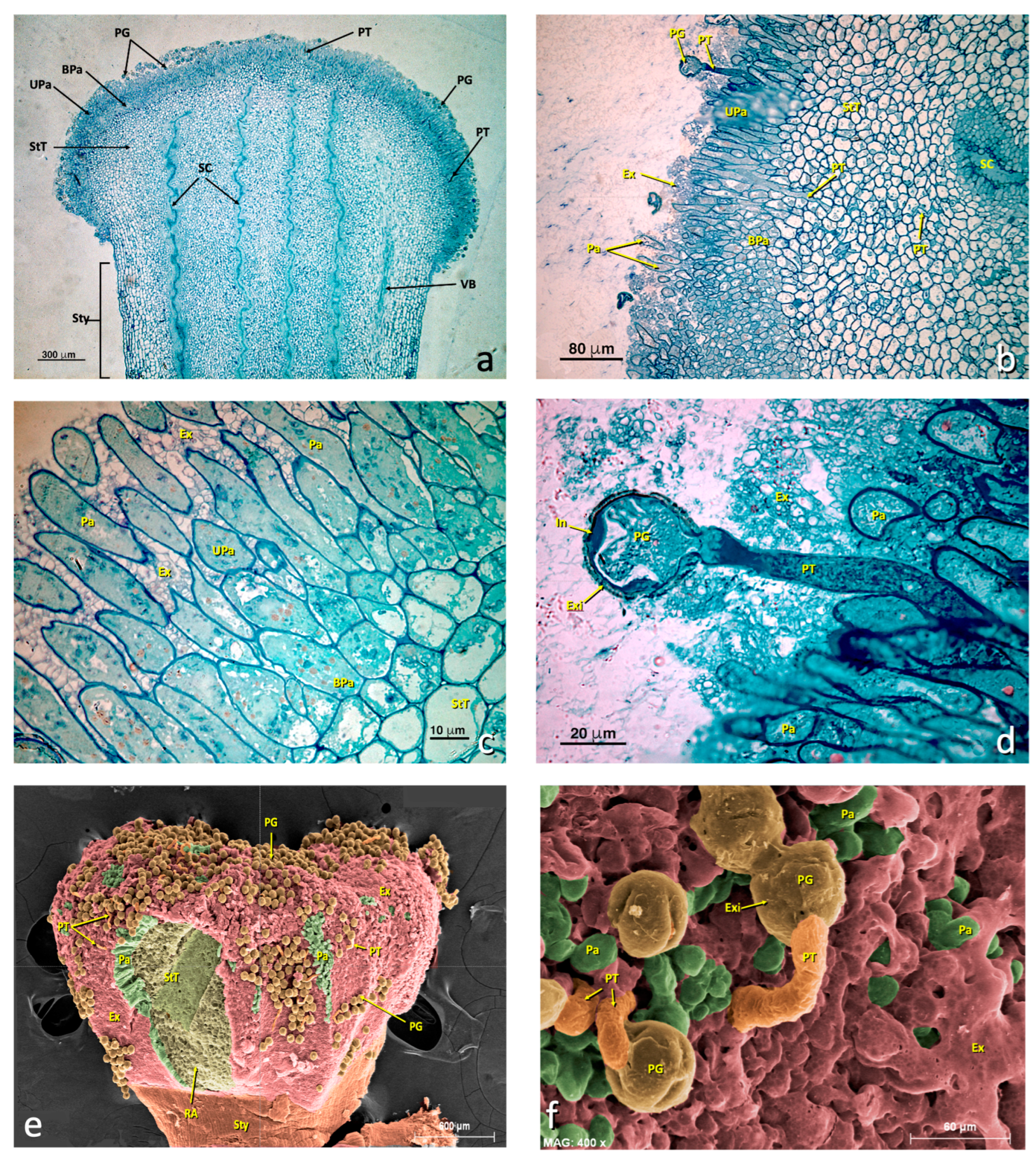
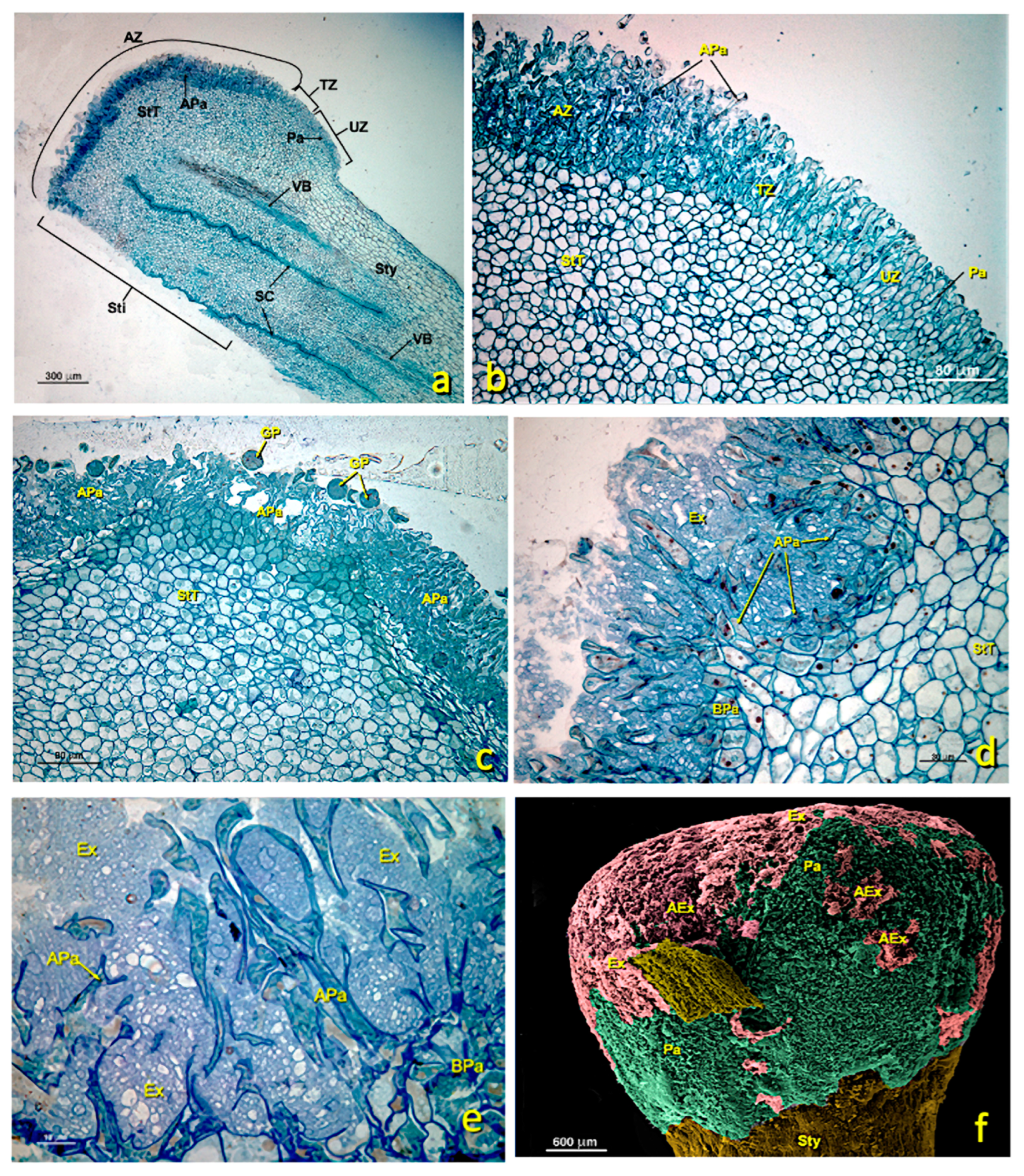
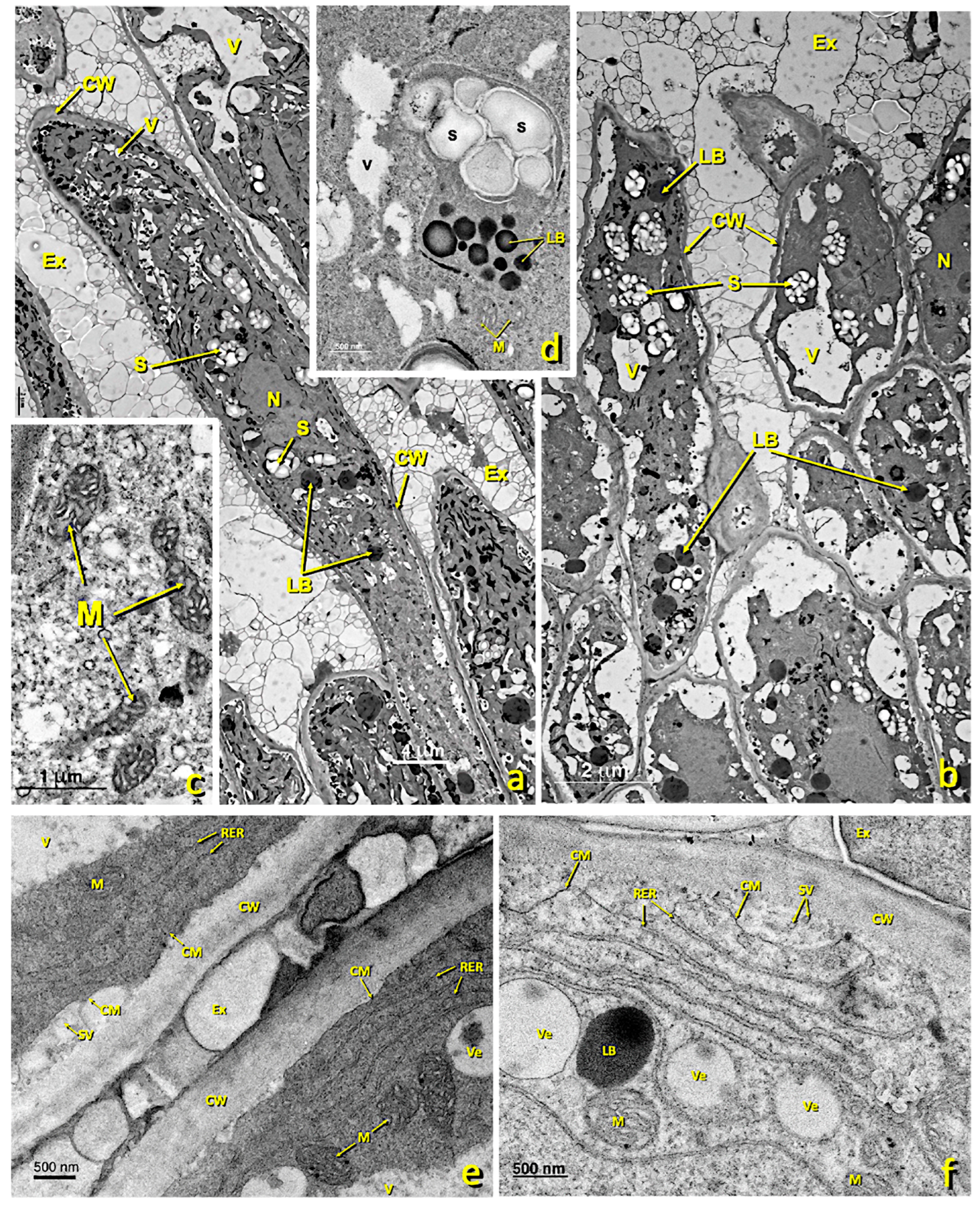
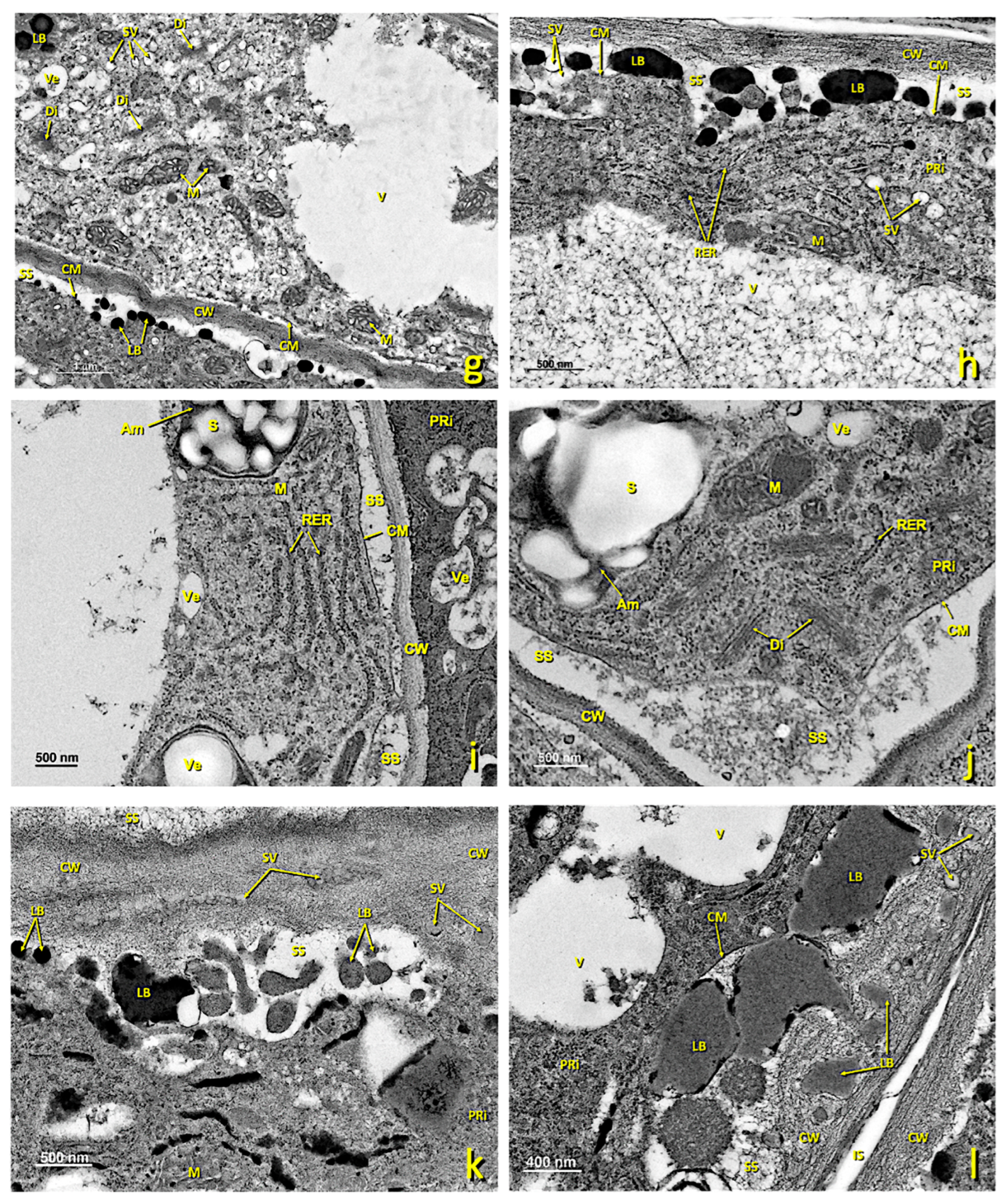
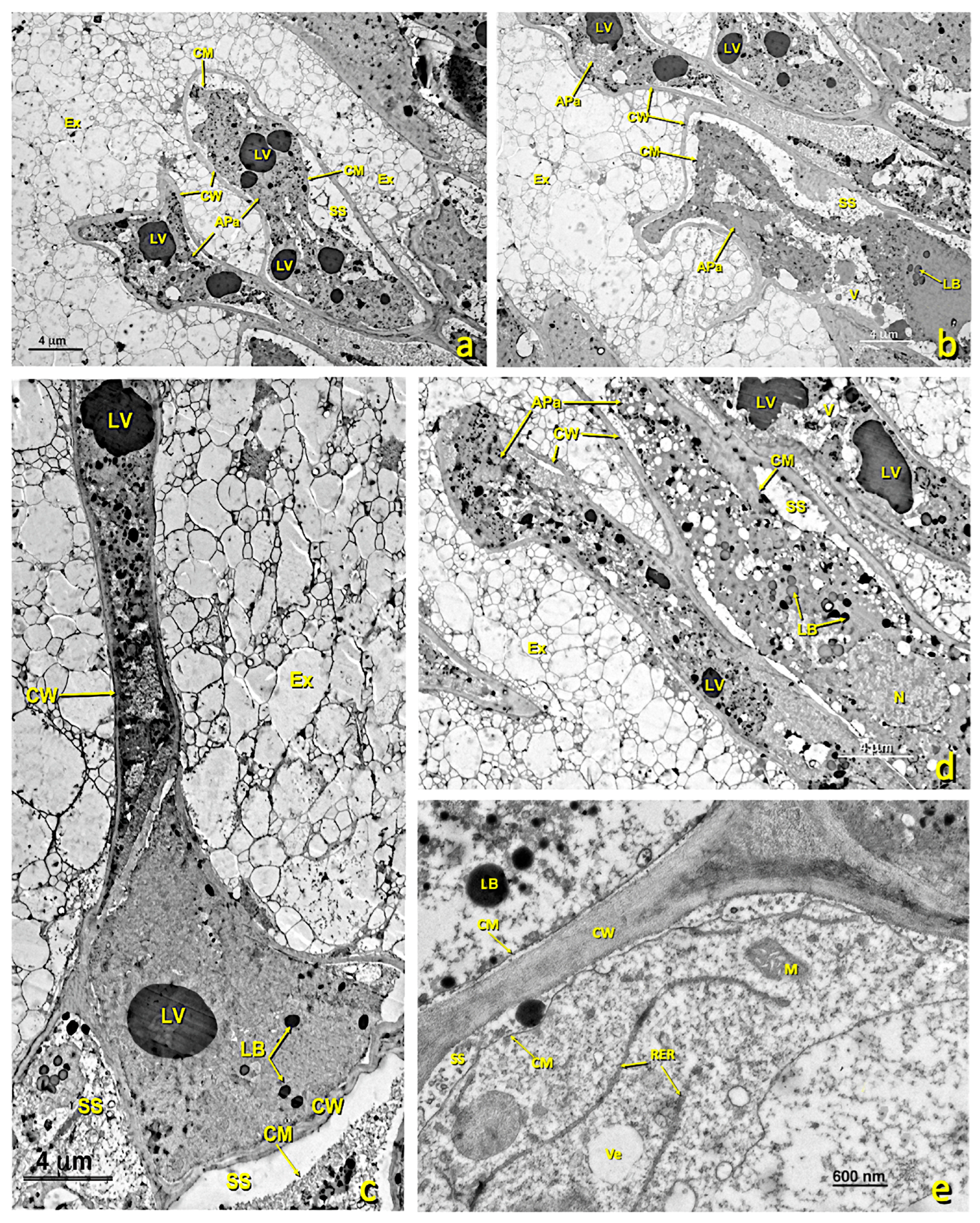

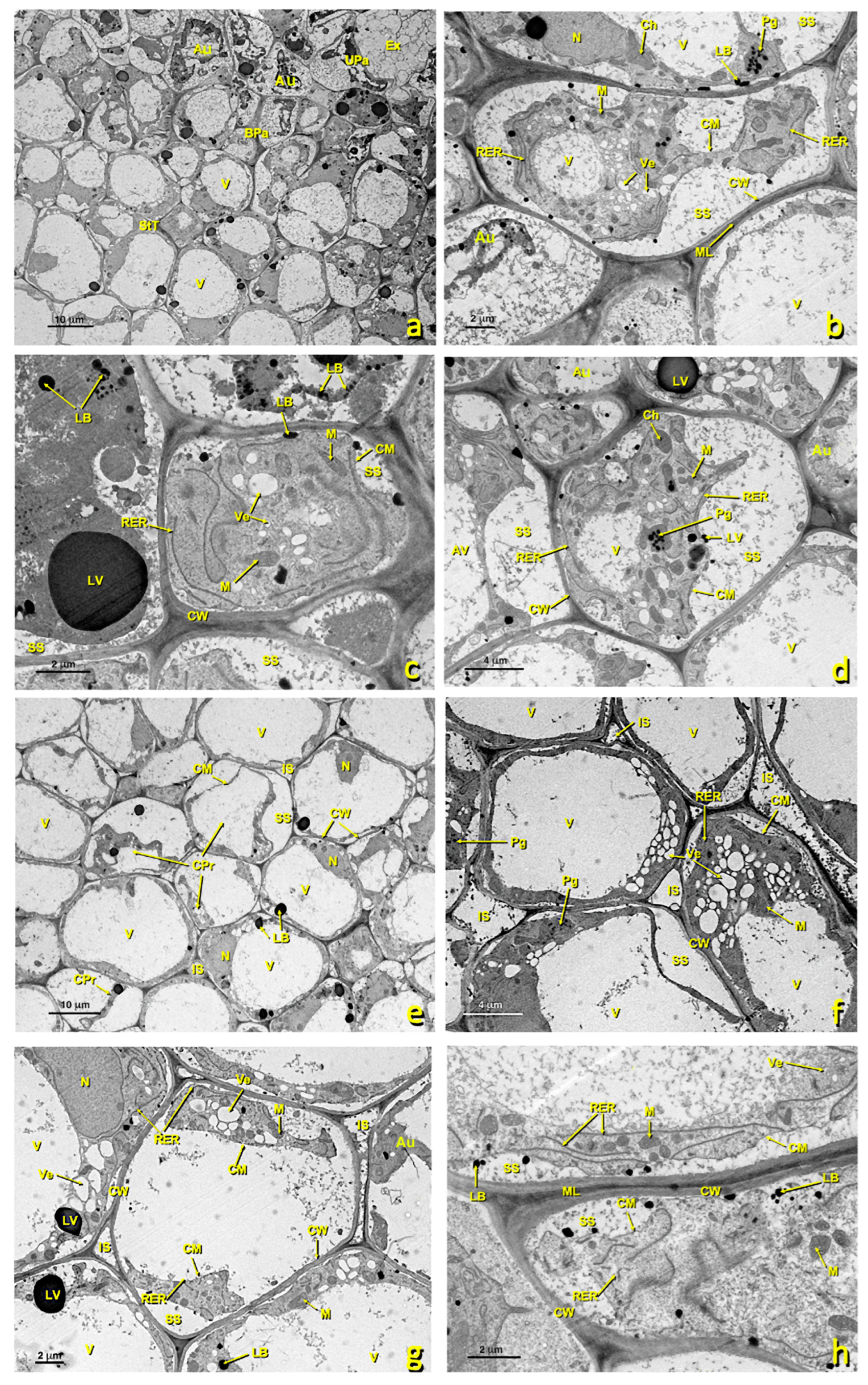

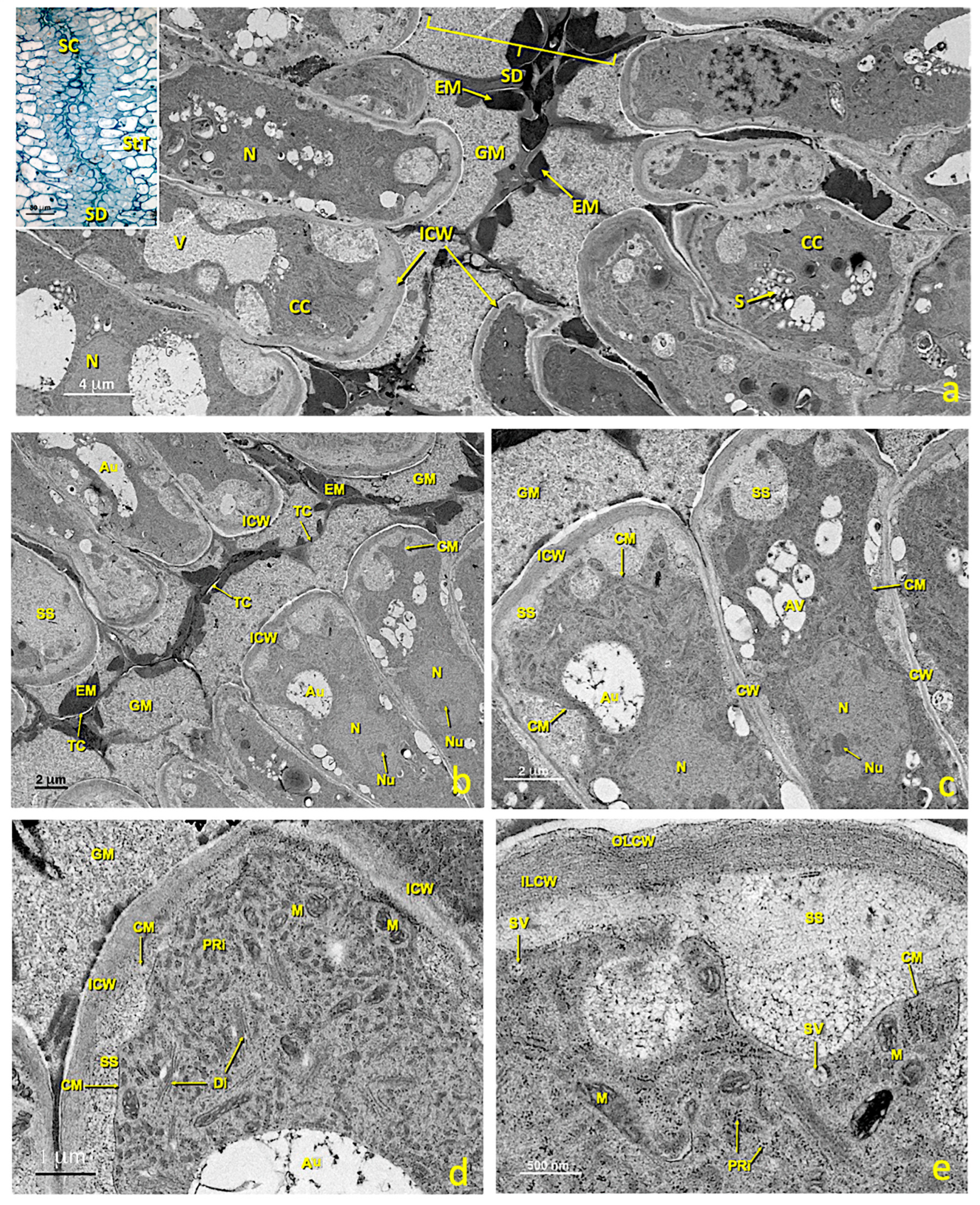
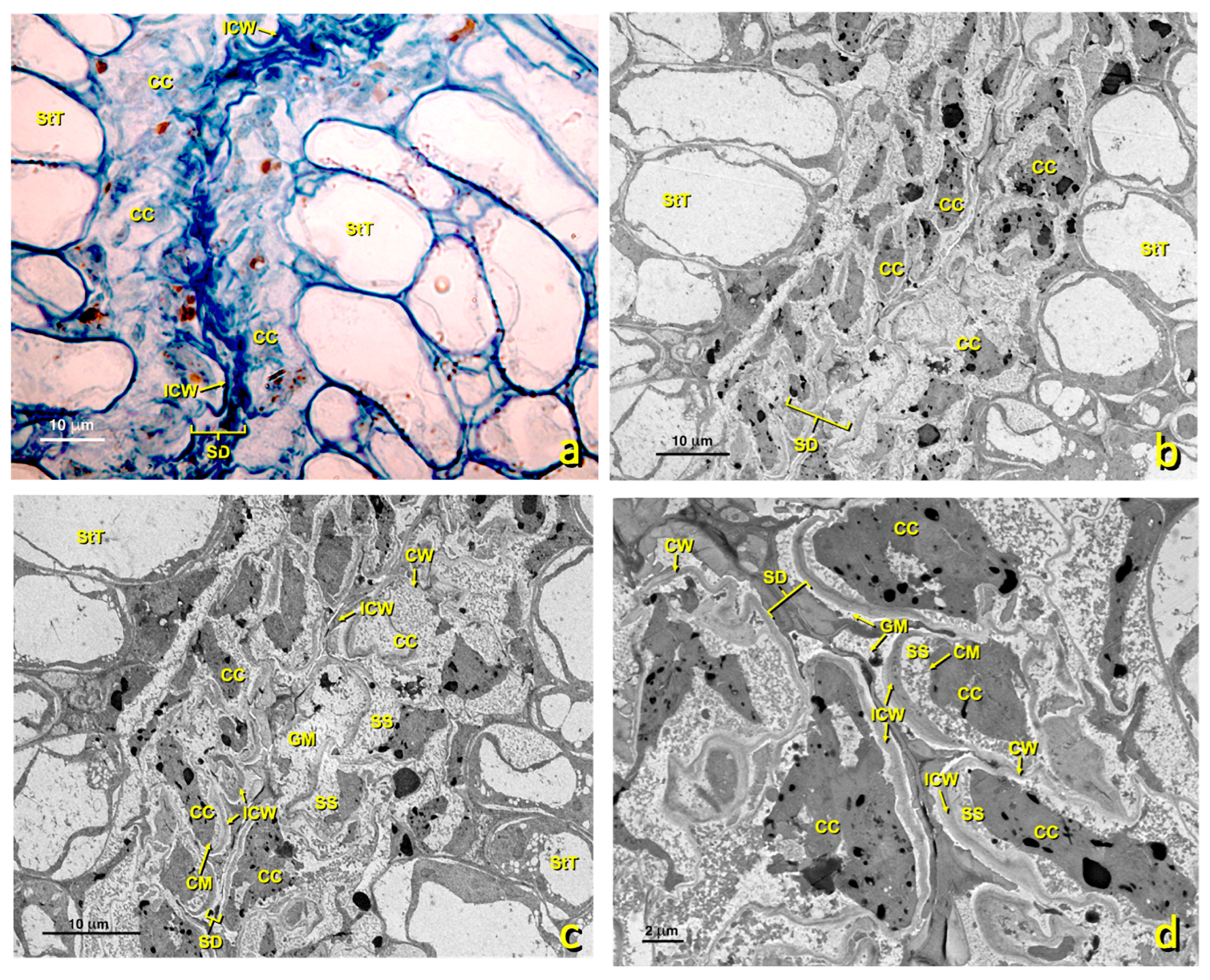
Disclaimer/Publisher’s Note: The statements, opinions and data contained in all publications are solely those of the individual author(s) and contributor(s) and not of MDPI and/or the editor(s). MDPI and/or the editor(s) disclaim responsibility for any injury to people or property resulting from any ideas, methods, instructions or products referred to in the content. |
© 2023 by the authors. Licensee MDPI, Basel, Switzerland. This article is an open access article distributed under the terms and conditions of the Creative Commons Attribution (CC BY) license (https://creativecommons.org/licenses/by/4.0/).
Share and Cite
García-Breijo, F.; Reig, J.; Cebrián, N.; Garmendia, A.; Beltrán, R.; Zornoza, C.; Merle, H. Ultrastructural Evidence Elucidates the Mode of Action of Sulfur in Preventing Pollen Tube Development in Stigma of Citrus cv. Nadorcott and Other Horticultural Species. Agronomy 2023, 13, 1643. https://doi.org/10.3390/agronomy13061643
García-Breijo F, Reig J, Cebrián N, Garmendia A, Beltrán R, Zornoza C, Merle H. Ultrastructural Evidence Elucidates the Mode of Action of Sulfur in Preventing Pollen Tube Development in Stigma of Citrus cv. Nadorcott and Other Horticultural Species. Agronomy. 2023; 13(6):1643. https://doi.org/10.3390/agronomy13061643
Chicago/Turabian StyleGarcía-Breijo, Francisco, José Reig, Nuria Cebrián, Alfonso Garmendia, Roberto Beltrán, Carlos Zornoza, and Hugo Merle. 2023. "Ultrastructural Evidence Elucidates the Mode of Action of Sulfur in Preventing Pollen Tube Development in Stigma of Citrus cv. Nadorcott and Other Horticultural Species" Agronomy 13, no. 6: 1643. https://doi.org/10.3390/agronomy13061643
APA StyleGarcía-Breijo, F., Reig, J., Cebrián, N., Garmendia, A., Beltrán, R., Zornoza, C., & Merle, H. (2023). Ultrastructural Evidence Elucidates the Mode of Action of Sulfur in Preventing Pollen Tube Development in Stigma of Citrus cv. Nadorcott and Other Horticultural Species. Agronomy, 13(6), 1643. https://doi.org/10.3390/agronomy13061643







